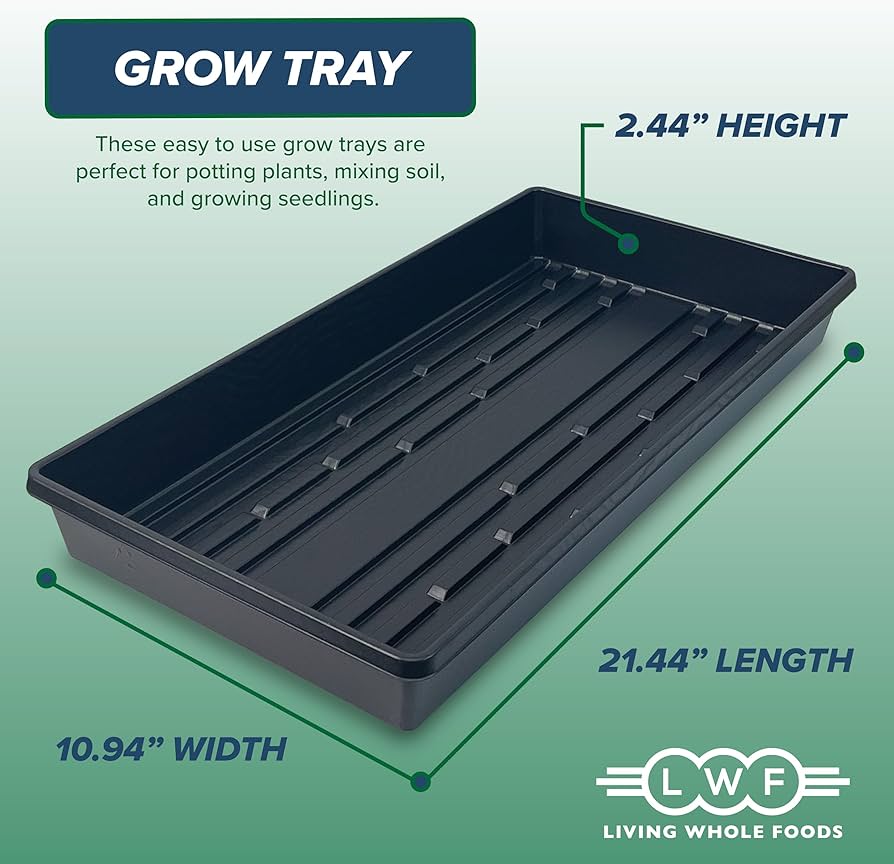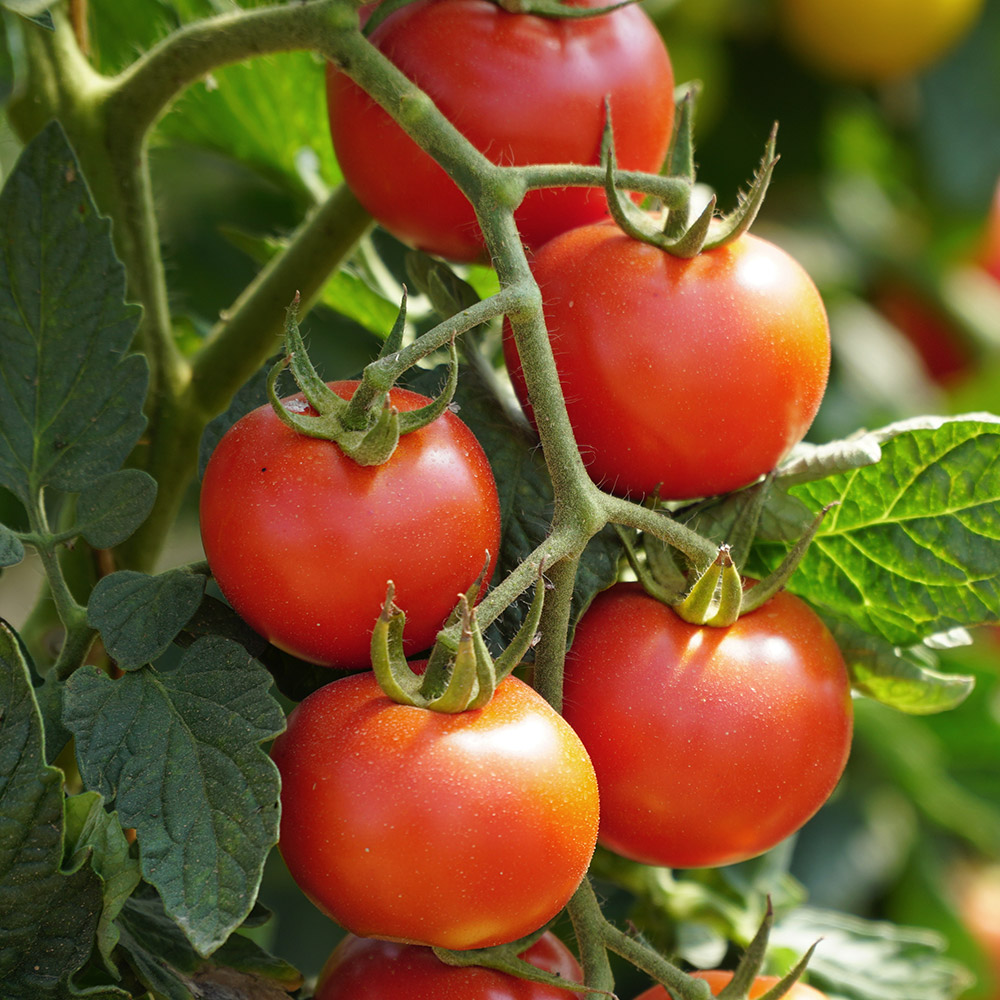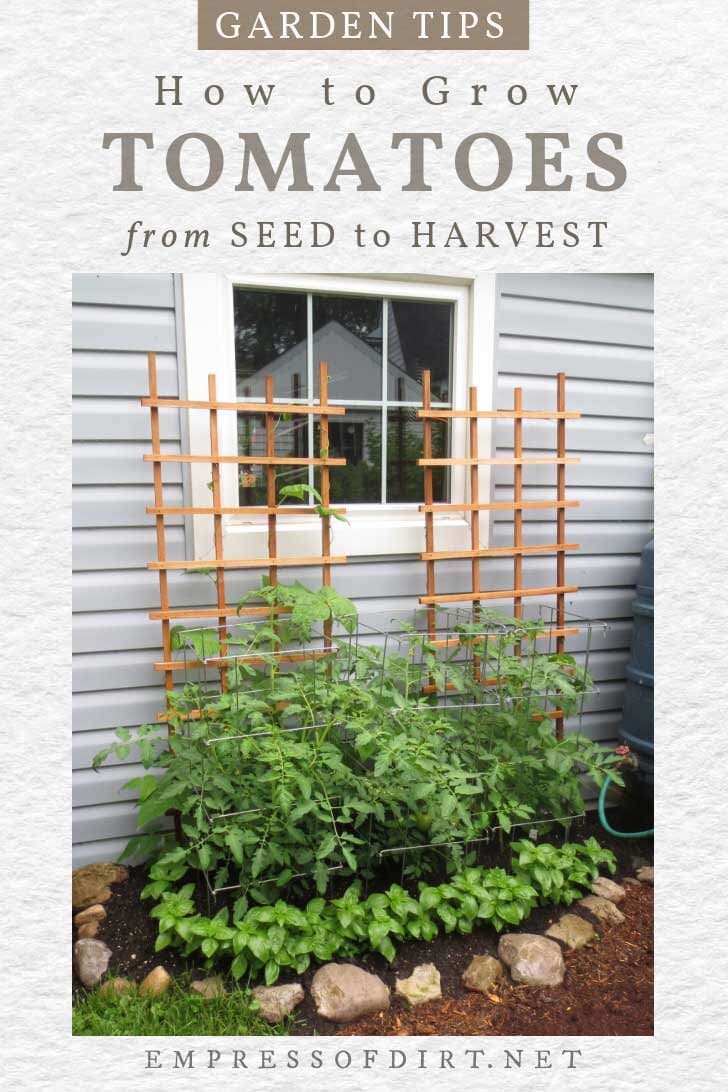Growing juicy tomatoes in your garden is achievable with a few simple & effective tips. Firstly, choose The right variety that is suited To your climate & growing conditions. Ensure your soil is well-drained & rich in organic matter. Regular watering is crucial, especially in hot weather, but avoid overwatering To prevent diseases. Prune your plants regularly To improve air circulation & remove any suckers. Additionally, providing support like stakes or cages will help your plants grow upright & avoid disease. Finally, fertilize your tomato plants throughout The growing season To promote healthy & abundant fruit production.
Simple and Effective Tips for Growing Juicy Tomatoes in Your Garden. Get ready To grow The juiciest tomatoes in your garden with our simple & effective tips. No complex terms or jargon, just straightforward advice for delicious results. Discover The secrets To growing tomato perfection with ease.
Simple & Effective Tips for Growing Juicy Tomatoes in Your Garden
Growing your own tomatoes can be a rewarding experience, & with The right tips & techniques, you can enjoy juicy, flavorful tomatoes straight from your garden. Whether you are a beginner or have some experience in gardening, these simple & effective tips will help you achieve The best results. In this article, we will cover everything from selecting The right tomato variety To providing optimal growing conditions & caring for your plants. Let’s dive in & discover The secrets To growing mouthwatering tomatoes!
Choosing The Right Tomato Varieties
When it comes To growing tomatoes, choosing The right variety is crucial for a successful harvest. There are numerous tomato varieties available, each with its own characteristics & flavor profiles. Here are a few popular options:

- Determinate Varieties: These tomatoes are compact & bushy, making them perfect for small gardens or container gardening. They produce a concentrated yield, making them ideal for preserving.
- Indeterminate Varieties: Indeterminate tomatoes are vining plants that continue To grow & produce fruit throughout The season. They require staking or trellising for support.
- Heirloom Varieties: Heirloom tomatoes come in a wide range of colors & flavors. They are open-pollinated varieties that have been passed down through generations.
- Cherry Varieties: Cherry tomatoes are small & sweet, perfect for snacking or adding To salads. They are prolific producers & great for beginner gardeners.
- Beefsteak Varieties: Beefsteak tomatoes are large & meaty, making them ideal for slicing & using in sandwiches or burgers.
Before choosing a variety, consider your garden space, climate, & personal taste preferences. It’s also a good idea To look for disease-resistant varieties To minimize potential problems.
Preparing The Soil
Tomatoes thrive in well-drained, nutrient-rich soil. Before planting, prepare The soil by removing any weeds & adding organic matter, such as compost or aged manure. This will improve The soil’s fertility & structure, providing a healthy environment for your tomato plants. Additionally, make sure The soil’s pH level is between 6.0 & 6.8, as tomatoes prefer slightly acidic conditions.
Planting & Transplanting
Tomatoes can be started from seeds or purchased as seedlings from nurseries. If you choose To start from seeds, sow them indoors 6-8 weeks before The last expected frost date in your area. Once The danger of frost has passed & The soil has warmed up, you can transplant your seedlings into The garden.
When transplanting seedlings, dig a hole slightly larger than The root ball & gently place The plant in The hole. Ensure that The soil covers The stems up To The first set of leaves. This encourages The plant To develop a strong root system. Space The plants about 2-3 feet apart To allow for adequate airflow & sunlight.
Pro Tip: To give your plants an extra boost, add a handful of organic fertilizer or a balanced tomato fertilizer into The planting hole.
Providing Optimal Growing Conditions
Tomatoes thrive in warm & sunny conditions. Choose a location in your garden that receives at least 6-8 hours of direct sunlight each day. If you live in a hot climate, providing some afternoon shade can help protect The plants from scorching heat.
It’s also important To provide a support system for indeterminate varieties. Staking or trellising The plants not only keeps them upright but also improves air circulation & reduces The risk of diseases. You can use tomato cages, stakes, or trellises To support The plants.
Watering is crucial for tomato plants, especially during The hot summer months. Keep The soil consistently moist, but not waterlogged. Water at The base of The plants early in The morning To allow The foliage To dry quickly & prevent diseases.
Fertilizing & Mulching
Tomatoes are heavy feeders & require regular fertilization To ensure healthy growth & abundant fruit production. Use a balanced organic fertilizer or a tomato-specific fertilizer according To The package instructions. Apply The fertilizer every 4-6 weeks throughout The growing season.
Mulching is another important practice that helps conserve moisture, suppress weeds, & regulate soil temperatures. Apply a layer of organic mulch, such as straw or wood chips, around The base of The plants. This will also prevent soil splashing onto The leaves & reduce The risk of diseases.
Pruning & Training
To promote better air circulation & prevent diseases, it’s recommended To prune & train your tomato plants. Remove The suckers, which are The small shoots that develop in The leaf axils. This directs The plant’s energy towards fruit production instead of excessive foliage.
You can also train indeterminate varieties by gently tying The main stem To a stake or trellis as they grow taller. This keeps The plants organized & makes harvesting easier.
Pest & Disease Control
Tomatoes can be vulnerable To various pests & diseases, such as aphids, tomato hornworms, blight, & powdery mildew. To minimize The risk, practice good garden hygiene by removing any diseased or infested plant material. Regularly inspect your plants for signs of pests or diseases & take appropriate action, such as using organic insecticides or fungicides if necessary.
Companion planting can also help deter pests & improve The overall health of your tomato plants. Some beneficial companions for tomatoes include basil, marigold, & borage.
My Experience Growing Tomatoes
As an avid gardener, I have had great success growing juicy tomatoes in my garden. It’s truly satisfying To harvest ripe, flavorful tomatoes that I grew myself. Over The years, I have experimented with different tomato varieties, growing techniques, & pest control methods. I have learned from both successes & failures, refining my approach To achieve The best results.
Simple and Effective Tips for Growing Juicy Tomatoes in Your Garden

Section 1: Preparing The Soil
The first step in growing juicy tomatoes in your garden is To prepare The soil. Start by clearing The area of any debris & weeds. Loosen The soil using a garden fork or tiller To a depth of at least 12 inches. This will allow The roots of The tomato plants To penetrate The soil easily & absorb nutrients.
Next, enrich The soil with organic matter such as compost or well-rotted manure. This will improve The soil structure & provide essential nutrients for The tomatoes. Spread a 2 To 4-inch layer of organic matter on top of The soil & mix it in thoroughly.
Finally, test The pH level of The soil. Tomatoes prefer a slightly acidic soil with a pH between 6.0 & 6.8. You can use a pH testing kit available at garden centers To determine The pH level. If The soil is too acidic, add lime To raise The pH, & if it is too alkaline, add sulfur To lower The pH.
Section 2: Choosing The Right Tomato Varieties
When it comes To growing juicy tomatoes, choosing The right varieties is crucial. There are many different types of tomatoes available, such as beefsteak, cherry, roma, & heirloom.
Consider The growing conditions in your garden, as well as your personal preferences for taste & size. Some tomatoes are better suited for warm climates, while others are more resistant To common diseases.
Take into account The space you have available for growing tomatoes. Determinate varieties grow To a certain height & stop, making them more suitable for containers or smaller gardens. Indeterminate varieties continue To grow & produce fruit throughout The season, but they require more space & support.
Section 3: Providing Proper Support
Tomato plants are vigorous growers, & they need proper support To prevent them from sprawling on The ground. There are various methods you can use To support your tomato plants, such as stakes, cages, or trellises.
Stakes are a simple & cost-effective way To support tomato plants. Drive a sturdy stake into The ground next To each plant, & gently tie The main stem To The stake using soft twine or plant ties. This will prevent The plant from bending or breaking under The weight of The fruit.
Cages are another popular method for supporting tomato plants. Place a cage around each plant, making sure it is tall enough To support The plant’s growth. As The tomato plant grows, gently tuck The branches inside The cage To keep them upright.
Section 4: Proper Watering Techniques
Watering is crucial for growing juicy tomatoes. Tomatoes need consistent moisture, but they don’t like soggy soil. The best way To water tomatoes is deeply & infrequently. Water The plants at The base, aiming for The soil rather than The leaves.
One method you can use is drip irrigation, which delivers water directly To The roots of The plants. This ensures that The water reaches The plant’s roots efficiently without wetting The foliage, which can lead To disease.
Monitor The moisture level of The soil regularly. Stick your finger into The soil up To The second knuckle. If it feels dry at that depth, it’s time To water. On average, tomatoes need about 1 To 1.5 inches of water per week, depending on The weather conditions.
Section 5: Fertilizing & Pruning
Fertilizing is an important aspect of growing juicy tomatoes. Start by applying a balanced organic fertilizer at planting time. This will provide The necessary nutrients for The plants To grow & produce fruit.
As The plants continue To grow, you can top-dress them with compost or well-rotted manure To give them an extra boost. Avoid over-fertilizing, as this can lead To excessive foliage growth at The expense of fruit production.
Pruning is another technique that can improve The quality of your tomatoes. Remove The suckers, which are The small shoots that grow in The leaf axils of The plants. This directs more energy towards fruit production & improves air circulation, reducing The risk of disease.
Section 6: Pest & Disease Control
Tomato plants are susceptible To various pests & diseases. It’s important To keep an eye out for any signs of trouble & take action promptly.
Aphids, hornworms, & whiteflies are common pests that can infest tomato plants. You can control them by using natural predators such as ladybugs or by spraying The plants with insecticidal soap.
Diseases such as blight, blossom-end rot, & powdery mildew can also affect tomato plants. Ensure good air circulation by spacing The plants properly & removing any diseased leaves or fruits. Apply organic fungicides as a preventive measure.
Section 7: Harvesting & Storage
Finally, The rewarding part of growing juicy tomatoes comes when it’s time To harvest them. Tomatoes are ready To be picked when they are firm, fully colored, & have a slight give when gently squeezed.
To harvest The tomatoes, twist them gently or use a pair of shears To cut The stem. Avoid pulling The fruits off The vine, as this can damage The plant.
If you have an abundance of tomatoes, you can store them by canning, freezing, or drying. Canning involves preserving The tomatoes in jars with vinegar or lemon juice. Freezing requires blanching The tomatoes briefly & then storing them in airtight containers. Drying involves slicing The tomatoes & dehydrating them until they are leathery.
Comparison Table
| Aspect | Your Garden Worker | The Almanac |
|---|---|---|
| Preparation of Soil | 🌱🌱🌱 | 🌱🌱 |
| Choosing Tomato Varieties | 🍅🍅🍅 | 🍅🍅 |
| Providing Support | ⚙⚙⚙ | ⚙⚙ |
| Watering Techniques | 💧💧💧 | 💧💧 |
| Fertilizing & Pruning | ✂✂✂ | ✂✂ |
Overall, growing juicy tomatoes in your garden requires careful attention To soil preparation, variety selection, support, watering, fertilizing, pruning, & pest & disease control. By following these simple & effective tips, you can enjoy a bountiful harvest of delicious tomatoes.
As a gardener myself, I have found that implementing these tips has significantly improved The quality of tomatoes in my own garden. The satisfaction of growing your own juicy tomatoes is unmatched, & I encourage every gardening enthusiast To give it a try!
For more detailed information on growing tomatoes, you can visit this link. Additionally, if you’re interested in other gardening topics, you can explore this website for valuable resources & insights.
Simple and Effective Tips for Growing Juicy Tomatoes in Your Garden
How do I grow juicy tomatoes in my garden?
To grow juicy tomatoes in your garden, follow these simple & effective tips:
What type of soil should I use for growing tomatoes?
Use well-draining soil that is rich in organic matter. Avoid compacted soil or heavy clay as tomatoes prefer loose soil for optimal root growth.
How often should I water tomato plants?
Water tomato plants regularly, aiming for about 1-1.5 inches of water per week. During hot & dry periods, increase The frequency of watering To prevent The soil from drying out.
Should I use fertilizers for tomato plants?
Yes, fertilizers can greatly benefit tomato plants. Use a balanced fertilizer with a higher concentration of phosphorus & potassium. Apply The fertilizer according To package instructions, usually before planting & during The growing season.
How can I support tomato plants as they grow?
Tomato plants require support To prevent The vines from sprawling on The ground. You can use cages, stakes, or trellises To keep The plants upright. Secure The plants gently To avoid damaging The stems.
How can I prevent pests & diseases in tomato plants?
To prevent pests & diseases, practice good garden hygiene. Keep The area clean from debris & remove any infected plants promptly. Consider using organic pest control methods or natural deterrents like neem oil.
When is The best time To harvest tomatoes?
Harvest tomatoes when they are fully ripe & have reached their desired color. Gently twist or cut The tomatoes from The vine To avoid damaging The plant. Enjoy your juicy homegrown tomatoes!
Conclusion
In conclusion, growing juicy tomatoes in your garden can be a rewarding & enjoyable experience. By following some simple & effective tips, you can enhance The quality & taste of your homegrown tomatoes.
First & foremost, ensure that your tomato plants receive adequate sunlight, as this is crucial for their growth & The production of flavorful fruits. Additionally, pay attention To The soil quality & ensure it is well-draining & enriched with organic matter. Providing proper nutrition through regular fertilization is also vital for The plants’ overall health & productivity.
Another important aspect of growing juicy tomatoes is pruning & supporting The plants. Regularly removing suckers & maintaining a sturdy support system will encourage better airflow, preventing diseases & allowing The fruits To ripen evenly.
Watering is a critical factor in tomato cultivation. It is essential To consistently provide sufficient water, keeping The soil consistently moist but not waterlogged. Mulching around The plants will help retain moisture & prevent weed growth, ensuring optimum conditions for The tomatoes To flourish.
Preventative measures against common tomato pests & diseases are essential. Regularly inspect your plants for signs of infestation or infection, & take appropriate action promptly. It is crucial To choose disease-resistant tomato varieties & practice crop rotation To minimize The risk of plant diseases.
Lastly, harvesting tomatoes at The right time is key To enjoying juicy & flavorful fruits. Gently squeeze The tomatoes To check for firmness & observe their color change. Once they reach The desired ripeness, harvest them carefully, ensuring you handle them with care To avoid bruising.
By following these simple & effective tips, you can have a bountiful harvest of delicious, juicy tomatoes straight from your garden. Happy gardening!
